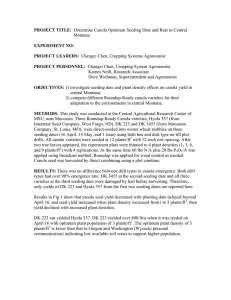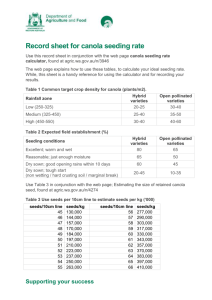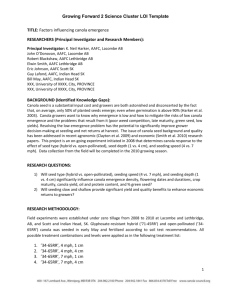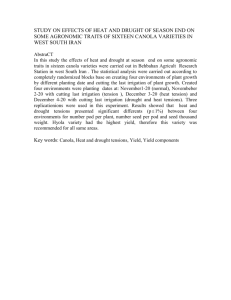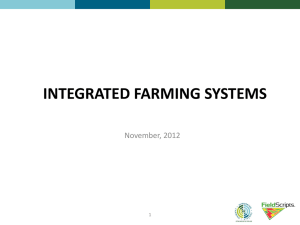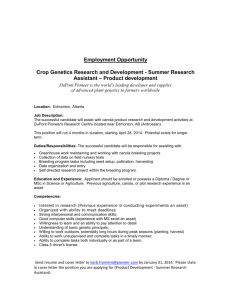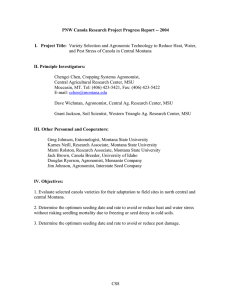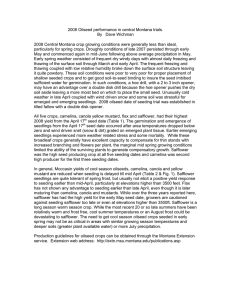and Pest Stress of Canola in Central Montana
advertisement
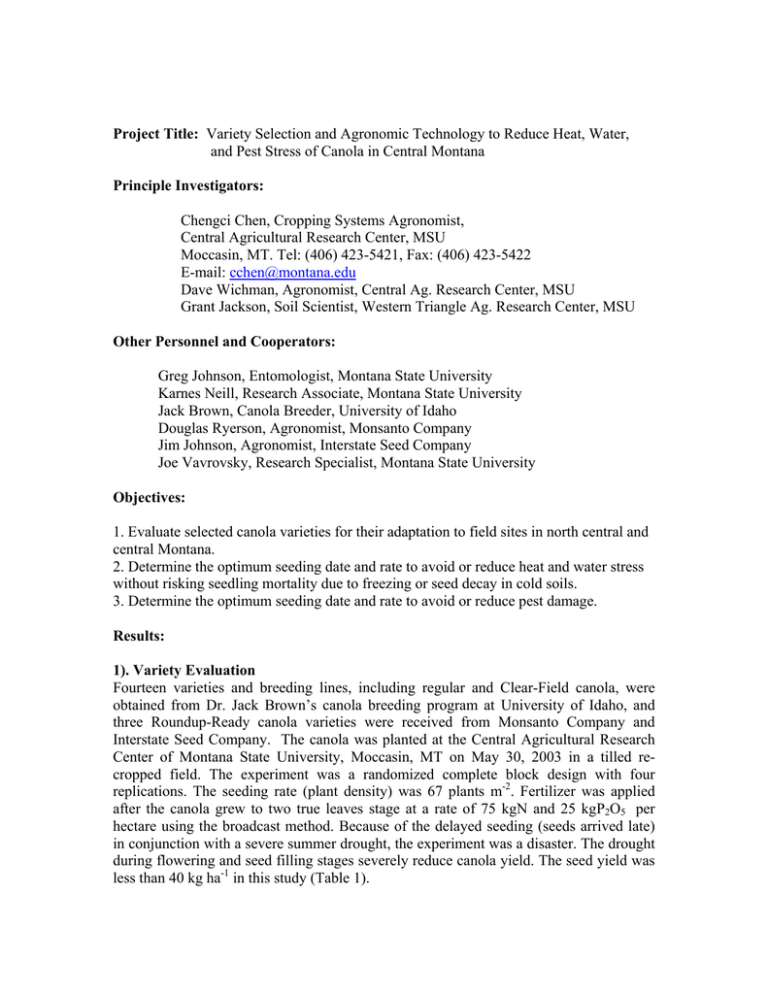
Project Title: Variety Selection and Agronomic Technology to Reduce Heat, Water, and Pest Stress of Canola in Central Montana Principle Investigators: Chengci Chen, Cropping Systems Agronomist, Central Agricultural Research Center, MSU Moccasin, MT. Tel: (406) 423-5421, Fax: (406) 423-5422 E-mail: cchen@montana.edu Dave Wichman, Agronomist, Central Ag. Research Center, MSU Grant Jackson, Soil Scientist, Western Triangle Ag. Research Center, MSU Other Personnel and Cooperators: Greg Johnson, Entomologist, Montana State University Karnes Neill, Research Associate, Montana State University Jack Brown, Canola Breeder, University of Idaho Douglas Ryerson, Agronomist, Monsanto Company Jim Johnson, Agronomist, Interstate Seed Company Joe Vavrovsky, Research Specialist, Montana State University Objectives: 1. Evaluate selected canola varieties for their adaptation to field sites in north central and central Montana. 2. Determine the optimum seeding date and rate to avoid or reduce heat and water stress without risking seedling mortality due to freezing or seed decay in cold soils. 3. Determine the optimum seeding date and rate to avoid or reduce pest damage. Results: 1). Variety Evaluation Fourteen varieties and breeding lines, including regular and Clear-Field canola, were obtained from Dr. Jack Brown’s canola breeding program at University of Idaho, and three Roundup-Ready canola varieties were received from Monsanto Company and Interstate Seed Company. The canola was planted at the Central Agricultural Research Center of Montana State University, Moccasin, MT on May 30, 2003 in a tilled recropped field. The experiment was a randomized complete block design with four replications. The seeding rate (plant density) was 67 plants m-2. Fertilizer was applied after the canola grew to two true leaves stage at a rate of 75 kgN and 25 kgP2O5 per hectare using the broadcast method. Because of the delayed seeding (seeds arrived late) in conjunction with a severe summer drought, the experiment was a disaster. The drought during flowering and seed filling stages severely reduce canola yield. The seed yield was less than 40 kg ha-1 in this study (Table 1). Table 1. Canola seed source and yield for the field experiment at CARC in 2003. Cultivar UISC00135 96SI510312 Sunrise 95SH2511017 Impact UISC02314 UISH003197 UISC0038DE Clearwater UISC00317 Premier Garnet UISH0031923 Sterling DKL223 Hyola357 DKL3455 Source U of I U of I U of I U of I U of I U of I U of I U of I U of I U of I U of I U of I U of I U of I Monsanto Interstate Monsanto Note Clear-Field Roundup-Ready Roundup-Ready Roundup-Ready Yield (kg ha-1) 30.2 28.8 30.9 19.9 27.3 22.4 26.1 18.9 21.5 15.6 26.3 23.9 23.1 15.5 26.5 26.4 35.8 Seeding Date and Rate Study This study was conducted at the Central Agricultural Research Center (CARC) in 2002 and 2003 and at the Western Triangle Agricultural Research Center (WTARC) in 2003. Two glyphosate-tolerant canola varieties, Hyola 357 (Interstate Seed Company, West Fargo, ND)1 and DK 223 (Monsanto Company, St. Louis, MO), were direct-seeded into winter wheat stubble on three seeding dates (mid April, mid May, and early June) using a no-till plot drill with a 0.3 m row spacing. The canola plots were planted at seeding rates of 11, 33, 67, and 100 seeds m-2. The experiment was a split-split plot design with four replications. Planting dates were assigned to whole plots, varieties were assigned to subplots, and plant densities were assigned to sub-sub plots. Plot dimension was 1.5m x 9 m. After seedlings grew to 2 true leaves stage, 67 kgN ha-1 plus 22 kgP2O5 ha-1 was applied using the broadcast method. Glyphosate was applied for weed control as needed. Canola seed was harvested by direct combining using a plot combine. Seeding date and plant density significantly affected canola seed yield (P<0.05). Yield for the mid-April seeding date (Date 1) was greater than the mid-May seeding date (Date 2). The early June-seeded canola did not produce any seed. Seed yield increased with seeding rate increasing. This is different from the trial in 2002, where the highest seed 1 Mention of trade name does not constitute an endorsement. yield was produced at 33 to 67 plants m-2. Due to the severe summer drought in 2003, the seed yield was much lower than that in 2002 (Fig. 1). Seed Yield (kg ha-1) 1000 800 CARC02 CARC03 a WTARC03 1000 1000 800 800 a 600 600 400 a 600 b 400 b a b 200 b bc ab c b 400 a a a 0 0 Date 1 a b a 200 ab b Date 2 Seeding Date 200 b a a DK 223 Hyola357 0 Rate 1 Rate 2 Rate 3 Rate 4 Seeding Rate Cultivar Fig. 1. Canola yield as affected by seeding date, plant density, and genotype at CARC and WTARC in 2002 and 2003. Bars within the same series with the same letter atop were not significant different according Fisher’s protected LSD (P<0.05). In this study, grasshoppers became a big problem in June and July of 2003. We had to spray the insecticides several times to save the trial. Therefore, the seeding date effect on pest infestation (Objective 3) was not evaluated. Summary: Due to the severe summer drought, canola yield in 2003 was much lower than in 2002. Early seeding continued to receive higher yields than late seeding. Future Plans: Above results indicate that early seeding is critical for a higher canola yield. Since the minimum germination temperature was found to be less than 3 oC, we are planning to seed canola on April 1st in 2004 and monitor the seedling emergence and growth affected by cold temperatures. Because fall-seeding is not feasible in central Montana, selecting genotypes that can germinate in lower temperatures and tolerate cold temperatures of early spring is the only option for a higher canola yield in the region. The research team acknowledges the funding support from the PNW Canola Research Program.
